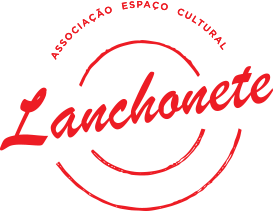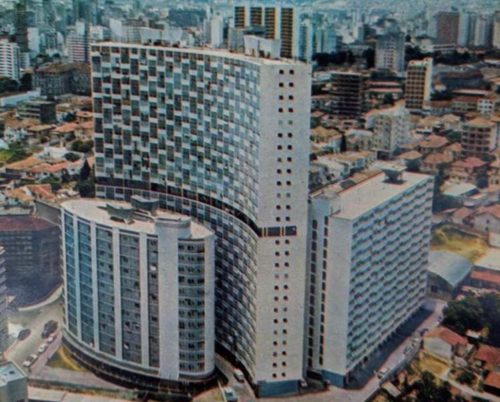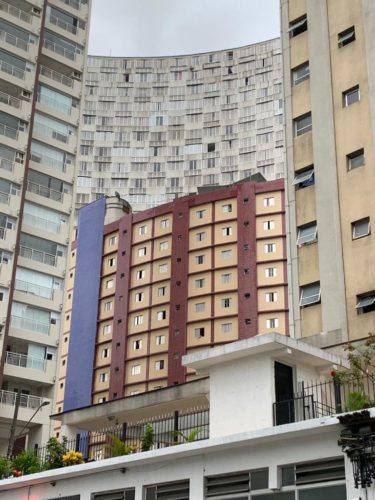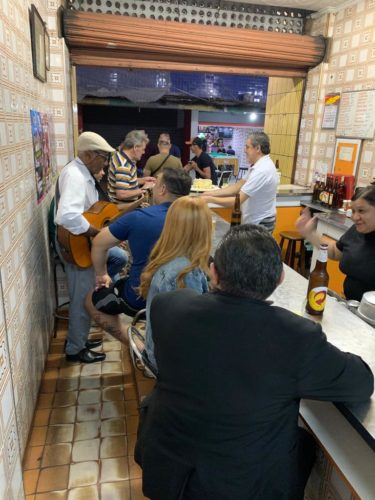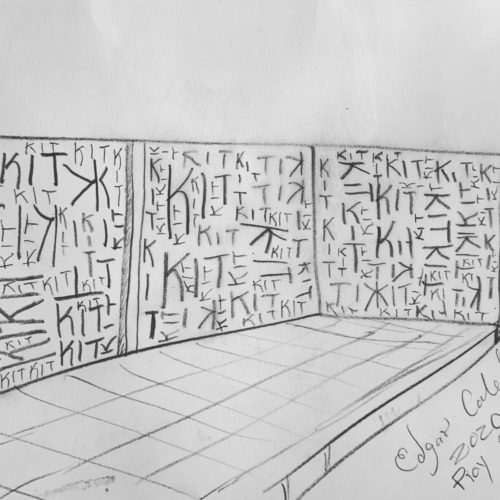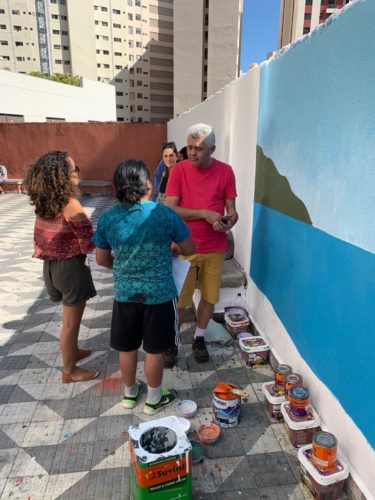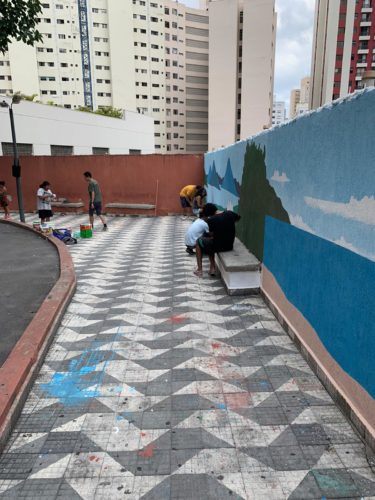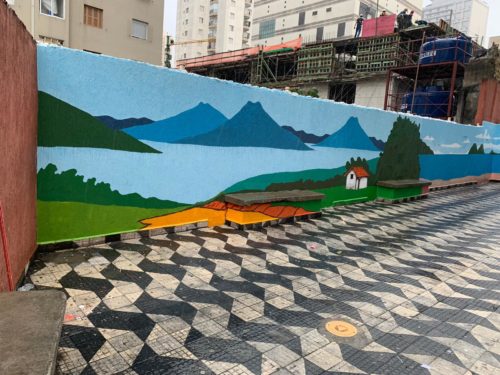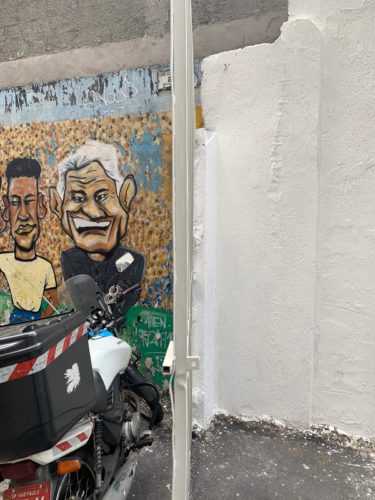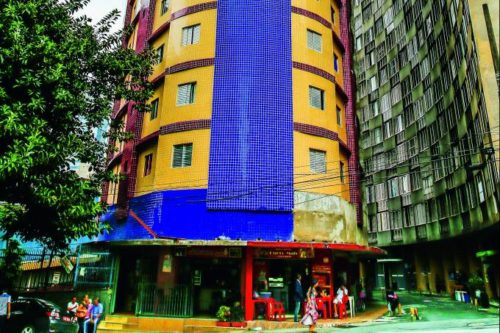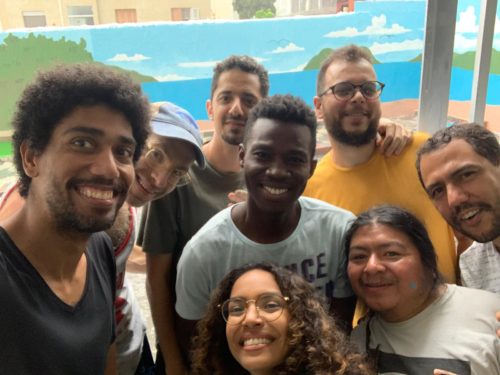Paim, final touch (pt. 1)
*Watercolor by Thiago Gonçalves depicting side views of Demoiselle and 14 Bis as well as ‘imagined’ airplanes on the 14 Bis lateral façade.
*See Paim, final touch (pt. 2).
From 2013-2017, Lanchonete.org was an artist-led, research platform focused on the right to the city—how people live and work in, navigate and share the contemporary metropolis—with the Center of São Paulo as its outlook. The name comes from the ubiquitous lunch counters—convivial, fluorescent-lit, open-walled, laborious, points of commerce—that populate almost every street corner. In 2016 the collective purchased a small lunch counter (Tarcisio’s Bar, Loja 3) at the base of 14 Bis, one of three buildings—including Demoiselle & Caravelle—that comprise Conjunto Santos Dumont. This began the present phase of the project , which is to develop a special relationship with the 4000+ inhabitants of Conjunto Santos Dumont and better understand the historic neighborhood of Bixiga in which it is located … by becoming a lanchonete owner.
Given all that occurred during the project’s five-year duration, we decided to prolong the platform for an additional year or ‘planning cycle’ in 2018, which took the form of a ‘closing programme’ at first but thereafter revealed an option of ‘leaving open’ the Lanchonete.org process and its momentum. For example what began as an ‘outbound’ exchange between Lanchonete.org’s partners and members (a ceremonial reunion) at Kaaysá Art Residency in Boiçucanga continued in a different form the following year when the makers of a mural onsite at Conjunto Santos Dumont, Edgar Calel and Fernando Pereira dos Santos began their residency period with a two-week stay at Kaaysá. Similarly we co-hosted Canadian artist Andrew O’Connor with Residência São João in Rio State, and co-hosted Anat Litwin with the International Seminar of Escola da Cidade ‘Still the Right to the City,’ also in 2019.
This type partnership with other Brazilian residency programmes began in 2015/2016 with Casa Tofiq, Goethe Institute and Bamako Encounters that hosted Lucia Nhamo from Zimbabwe in both São Paulo and Salvador, and again in 2018 with the Goethe Institutes in Sao Paulo and Salvador to co-host Berlin-based, Nigerian photographer, Akinbode Akinbiyi. Starting with Akinbode, one part of the exchange is the artist being present at Conjunto Santos Dumont and this experience conducted in contrast with another on the same trip such as a residency in Salvador (Goethe), Boiçucanga (Kaaysá) or rural Rio State (Residência São João).
Conjunto Santos Dumont, completed in 1956, first became a Northeastern regional enclave. A majority of inhabitants are from the state of Piauí. Sometime in the 1990s with general divestment in ‘14 Bis / 9 de Julho’ basin, the dead-end internal roadway of Conjunto Santos Dumont became a ‘drug den’ and the broader area was referred to as ‘little cracolândia’. One could walk to the end of the internal roadway between 14 Bis and Demoiselle, at the entrance of Caravelle to purchase marijuana, cocaine, etc., a market that exists until today. A gate separates the cul-de-sac from a courtyard within the official property of Caravelle building, a place where kids play and mothers meet to chat. Due to its sheer size—499 apartments, 4000+ inhabitants—it is arguable that Conjunto Santos Dumont is second only to Niemeyer’s Edifício Copan in relevance from São Paulo’s modernist period. And yet until only recently—and for some, still—going into Conjunto Santos Dumont is ‘dangerous.’ Over the past few decades a strong preconception /’dark cloud’ developed over the buildings of Conjunto Santos Dumont at once condemning its drug trade, and conflating its origin. As the neighborhood gentrifies and drug traffic lessens, the preconception is lifting. Lanchonete.org uses its conceptual and built-environment interventions as ‘soft wedges’ that help keep the public spaces of the compound opening at a pace that makes sense (or feels right) to its cautious residents, folks who once stayed mostly indoors to prevent encounters with the drug dealers and/or having their sons conscripted into the gang.
As these public spaces and practices now flourish, so does a pride of place and expressions of Northeastern culture. Just before COVID-19 struck and closed down the city, we began a mural project with visiting Guatemalteca artist, Edgar Calel in the Caravelle courtyard. This is a collaborative project that also includes Abdoulaye Guibila, Fernando Pereira dos Santos, and an architecture/urban planning collective called Margem. The original architect, Aron Kogan named the compound after Alberto Santos-Dumont and the buildings after airplanes he invented. Lanchonete.org’s ‘final touch’ will be a large-scale LED installation depicting Santos-Dumont’s airplanes on the 14 Bis building’s lateral façade, a work conceived by artist Thiago Gonçalves. Some common design motifs will be recognizable in the final section of the Caravelle courtyard mural and the eventual LED installation. We anticipate an announcement of this work during the 2022 Centennial of the ‘Modern Art Week’.
A formal drawing of Conjunto Santos Dumont, completed in 1956 by modernist architect Aron Kogan.
A rendering of Lanchonete.org’s original five-year project timeline overlaid on Conjunto Santos Dumont by artist Thiago Gonçalves.
View of Demoiselle and 14 Bis.
View into Tarcisio’s bar (Loja 3, 14 Bis Building), a traditional lunch counter open for four decades.
Guatemalteca artist, Edgar Calel’s proposal for a courtyard mural at Caravelle Building.
The first section of the wall was painted by Edgar and local youth, an interactive way to start the four- weekend process.
The following week Lanchonete.org and Edgar Calel engaged the ‘courtyard users’ to hone in on a desired aesthetic for the wall.
Caravelle building manager, Paulo was on our side, taking part in the entire process. While he had the whole back wall painted white, we were asked to do a ‘half mural’ at first to make sure everyone liked its look.
Based on universal acclaim, we were allowed to continue the following week, when a second scene (volcanic lake in Guatemala) was added to the first (Brazilian beach scene).
We finished it just before a heavy rainstorm.
The adjacent wall was clearly off limits to us at first; it was not painted white for the project despite our offer to include it.
Shortly after Edgar Calel’s mural was complete, Paulo had the maintenance team paint the adjacent wall white. We were officially invited to finish the outstanding wall (measuring 25 meters long and 3.5 meters tall) right as COVID-19 struck.
This wall connects to a painting, caricatures of the locally-favored football team.
View at entrance of internal road; tiled building on left is Demoiselle and Tarcisio’s bar (lanchonete) is on the right side at bottom of 14 Bis. *
A triumphant mural team.
*[Image credit: https://vejasp.abril.com.br/
